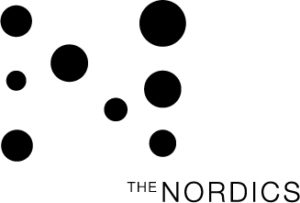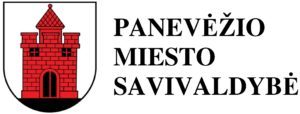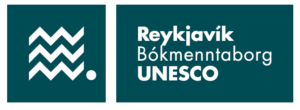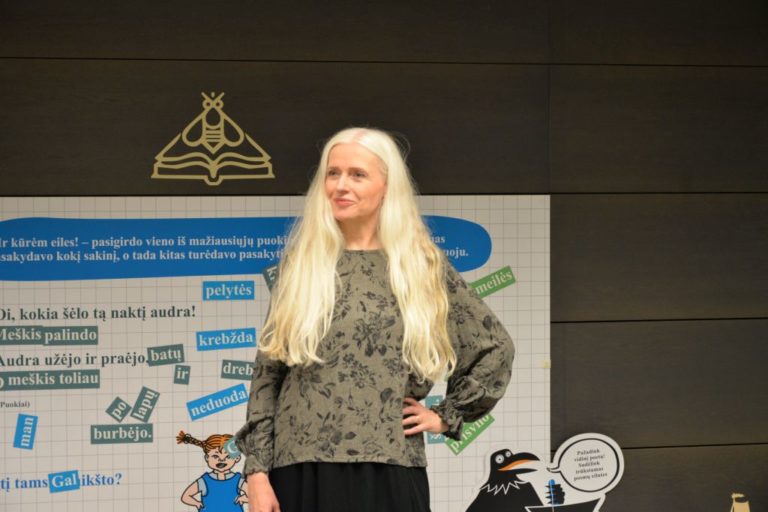September 13-15 The famous Icelandic writer and illustrator Kristín Ragna Gunnarsdóttir, who is the curator of the exhibition “Nordic Children’s Book Flood” visited Panevėžys County Gabrielė Petkevičaitė-Bitė Public Library.
Kristín Ragna Gunnarsdóttir (b. 1968) holds a bachelor’s degree in comparative literature and a master’s degree in creative writing. Having written 10 books and illustrated countless books, she creates exhibitions for children and contributes to reading promotion initiatives. The author has received the Icelandic Illustrators Award for illustrations from Nordic mythology books, and has been nominated for many literary awards.
How did books come into your life?
When I was one year old, we moved to London. Relatives sent Icelandic books – illustrated fairy tales, folk creations, stories about rural life. For a very long time in my imagination, Iceland was like in those ancient books for children. In the parcels I also received books translated into Icelandic by Nordic authors (Astrid Lindgren, Tovi Jansson, etc.) and wonderful English stories. I was a very eager reader.
What was your favorite childhood book?
I had a lot of favorite books. One of my favorites is “Alice in Wonderland.” It stimulated creativity and playfulness in me, fascinated me with the play of words. Other books on my favorites list: “The Brothers Lionheart”, “Peter Pan”, “The Hobbit”. Later we moved to America, where I got acquainted with the children’s literature of this country: “Charlotte’s cobweb”, “The Wizard of Oz”. Eventually we went back to Iceland, so I had the opportunity to get to know better Icelandic, Scandinavian literature for children. All these amazing books inspired me. And now, wherever I travel, I’m looking for children’s books, I keep reading them. I think the world would be much better if everyone read more children’s books.
What inspired you to start writing and illustrating books for children?
As I mentioned, as a child I read without stopping, but at the same time I felt a huge need for creativity. When nobody saw, I started coloring the illustrations of the books I was reading and drawing myself where there were no pictures. Growing up, during my vacation in the village, I began to create stories, which I wrote and illustrated and sent to my younger brother and sister. This creation continues to this day. I just really like the stories.
How are ideas born for a new book?
The idea lights up like a flame. Let’s say, working on one of the books, I suddenly looked at an old map of Iceland hanging on the wall and in my imagination I saw a scene: a girl touches a volcano, it erupts, and a mythological witch appears with it … I knew this witch was already angry that I didn’t include her into one series of books and will definitely reappear. After that, I have to come up with the whole story from which this scene came.
Sometimes stories are inspired by special places or things. When traveling, I really enjoy visiting museums and historical sites, so I can find inspiration in the basements of an old chapel or looking at a rare object in a museum.
What role does reading play in children’s lives and how does it compete with modern technology?
Technology definitely takes the place of reading. The action on the phone is engaging, changing much faster than in a book. Watching a movie and reading is not the same thing. While reading, children interpret the text, create images in their imagination, and while watching a film, the rapidly changing image simply floods and thus imposes a certain interpretation. When reading, children develop critical thinking, which is very important for filtering the flow of information.
Through books, children get to know themselves, their environment and the world better. This is how imagination and empathy develop. Reading is also indispensable in language development – an extremely important tool for self-knowledge and self-expression.
What measures do you think might encourage children to read? How is this done in Iceland?
Iceland is a nation of storytelling. Literature is an integral part of our daily lives. We set high standards for it. When it comes to encouraging children to read, I think the most important thing is to set a good example. We often say that children should spend less time at screens and more reading, and we don’t do that ourselves. Children need to see reading adults, we need to read together, talk about books.
It is also important to allow children to discover the books they like, so that reading is not an obligation imposed on them, but an enjoyable adventure. A wonderful place to search is the library. After all, libraries are museums full of stories from all over the world, and library staff are like magicians who help every child discover their way into the world of books. Children’s book exhibitions are also important, where books become part of the game. It is necessary to allow children to explore on their own, to make contact with the object, because it stimulates the imagination and children become part of the story.
Tell us, how was the idea for the exhibition “Nordic Children’s Book Flood” born?
The office of the Nordic Council of Ministers in Reykjavik celebrated its 50th anniversary and approached me to come up with an idea for an exhibition that would invite future visitors. I had organized exhibitions there before and got to know the office space well, and I had been working on initiatives to promote children’s reading for a long time, so the idea came very quickly.
I borrowed the name from the Icelandic term ‘book flood’, which describes the pre-holiday period when all publishers publish countless books and people rush to buy them as gifts. I wanted it to be a flood of children’s books flooding the whole space, with children sailing through it with a travel passport and feeling that reading – when we travel with our thoughts to the world created by the author – can be an exciting adventure.
What is special about Nordic literature for children?
In my opinion, the literature of these countries for children is of exceptional quality. In 2017 I was nominated for the Nordic Literature Prize and I had the opportunity to get to know the children’s book writers and illustrators in the region even better, to hear them speak. I think most Nordic children’s books are characterized by bold themes and the promotion of critical thinking.
And what is your favorite Nordic literary character for children?
I even wear a bracelet with a picture of Pippi Longstocking. I think this character is a great personification of Nordic literature. She is brave and questions everything. She looks at the world creatively – she can turn everything upside down, walk backwards. Teaching the art of creative writing and illustration, I also encourage students to be playful, creative, and look for different points of view. In addition, Pippi is an inspiring example for girls.
What would you like wish for the visitors of the exhibition?
I wish them to be curious, playful and have a good time. Immerse yourself in this adventure, take the time to delve into the details of the exhibition – texts, illustrations and get to know the Nordic children’s literature better.
The exhibition “Nordic Children’s Book Flood” was held for the first time in 2018 in Iceland. Next year the interactive exhibition traveled to Latvia. This year, by the initiative of the Nordic Council of Ministers’ Office in Lithuania and the Panevėžys County Gabrielė Petkevičaitė-Bitė Public Library as well as the creative cooperation of Icelandic and Lithuanian artists, reading promoters, architects, art school students, library specialists, the exhibition was presented in Lithuania for the first and only time. It is gratifying that together with Kristín Ragna Gunnarsdóttir, representatives of the Nordic Council of Ministers’ Office in Lithuania celebrating its 30th anniversary: Director Helen Nilsson and Cultural and Education Adviser Brigita Urmanaitė came to the exhibition in Panevėžys.
Project is funded by:
The Nordics
Nordic Council of Ministers
Panevėžio miesto savivaldybė
Reykjavik UNESCO cityofliterature





